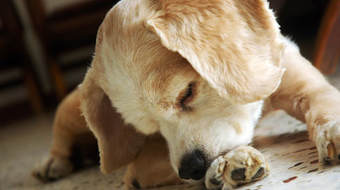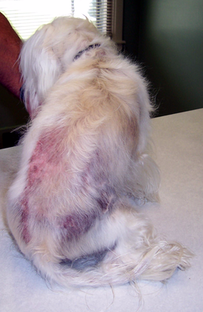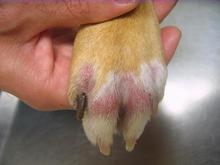 The number one problem I see dogs (and to a lesser extent in cats) is itching! I hear, "Doc, she is scratching all night long; it is driving me nuts" or "he licks his feet constantly". Itching is most commonly a sign of allergies. Other causes can include mange, fleas, a foreign body like a foxtail or thorn, a bug bite, etc. But skin allergies are VERY common. It's difficult to simplify allergies, but in general they fall into a few categories: 1. Environmental--this is due to pollen and dust that either gets inhaled or touches your pet's skin. It doesn't have to be plants just in your backyard. The pollen can be from trees and plants blooming miles away that blows in on the wind. Even if you keep your windows shut all the time, you yourself still walks outside from time to time and can carry in allergens.  2. Fleas/Ticks/Mosquitoes--a true flea allergy is an animal that is allergic to the saliva of the flea bite. So it only takes one bite to set off an allergic reaction. See the picture below for an example of flea "dirt" and a dog with a typical presentation for a flea bite allergy. Flea "dirt" is actually the feces from the flea. When you dab it with a bit of water on a white paper towel, you will see it turn red because the flea's feces is basically dried blood. For some reason, fleas really like the base of the tail, in the armpits and in the groin areas. For this reason, most dogs and cats will chew the heck out of their lower back and sides when they have a flea allergy.  3. Food Allergies--This is a slow brewing process where dogs and cats have an allergy to one or more ingredients in their food. It is not like a child with a peanut allergy that is very sudden and life-threatening. Food allergies tend to cause excessive gas, soft stools or diarrhea, scooting or "carpet surfing". Carpet surfing is when a dog rubs its face along the floor or a couch, especially after he/she eats food. That can indicate his/her face is very itchy. Food allergies can and do contribute to skin allergies overall, but it is not as common as people seem to think. Allergies from something in the environment and fleas are by far the most common causes. That being said, I will always recommend trying to reduce potential food allergens to eliminate them as a contributing factor. 4. Bacteria and Yeast--Bacteria and yeast are always present on our pets' skin in healthy numbers. When an animal has allergies, they often traumatize the skin by scratching it creating small breaks in the skin. Allergies also cause changes in the pH of their skin. The pH change and the tiny breaks in the skin allow bacteria and/or yeast grow in excessive numbers. This leads to stinky, smelly, super itchy dogs and cats. To make matters worse, some animals are allergic to the very bacteria and yeast that grow on their skin. Most animals with allergies have some type of bacterial or yeast overgrowth, which is why we have to use medicated shampoos and oral antibiotics or anti-fungals to treat the secondary infections that have developed. Below shows a slide image of yeast (the large "footprints") and bacteria (the smaller purple dots). There is relief, however! There are many options that can help your dog or cat who suffers from allergies. Two newer medications such as Apoquel and Cytopoint are doing absolute wonders for my canine patients. Check out www.itchcycle.com to understand the biology behind allergies. If your animal is suffering from an itch that never stops, please give us a call so we can find the right solution for your pet!
5 Comments
|
Archives
April 2019
Categories |
 RSS Feed
RSS Feed